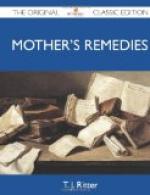In case the request “Kindly omit flowers” is made in the obituary notice, the wish of the family should be observed.
Letters of condolence should be written as soon as possible. Friends should not be afraid to intrude. If they feel a sincere sympathy it should be allowed expression, for such tributes, coming from the heart, are always grateful to the stricken. Answers to such letters should not be expected; it is customary to acknowledge them by a card, as above mentioned.
Friends who send flowers should be thanked, either by note, or word of mouth.
THE ETIQUETTE OF CORRESPONDENCE.
“Letters should be easy and natural, and convey to the persons to whom we send just what we would say if we were with them.”—Chesterfield.
They say nobody has time to write letters these days, and yet the post office department handles millions of them each year. True, they are not the formal, lengthy, somewhat stilted epistles of a century ago, when a lad began his home letters “Honoured Parents,” and your correspondent announced, “I take my pen in hand to inform you,” etc. The letter of today, however, is not less the messenger of good-will and remembrance than it was in those days. It remains largely the bulletin of business and of family affairs.
The postman’s bag! What may it not contain? News of birth or tidings of death, of lover’s vows made or broken, of achievements or misfortunes. Every letter is like a new day; we cannot tell what its message may be.
It is no mean accomplishment to be able to write a good letter.
[756 Mothers’ remedies]
The Essentials.—The first essential to letter-writing is to have something to say, and the ability to say it well. This is a talent that may be cultivated. The next requisite is good paper. Better curtail in some other item and allow yourself good, plain, heavy paper and envelopes. Avoid all fancy papers, whether in tint or design. Plain white or cream laid paper is always good form. Whatever the vagaries of the stationer, the plain white, fine quality paper is to be preferred. The intertwined initials of the writer are often placed at the top of the first page, either in the center or at the left-hand corner where the water-mark used to be. These are done in gold or silver, or some pale tint. Just now, the street address of the writer is often engraved across the flap of the envelope. The form of the latter, whether square or oblong, varies according to the passing fashion. Whichever is used, the letter sheet is folded once to fit it. Sealing-wax is little used at present; if at all, the “blob” of wax is small, only large enough to receive the impress of a single initial on the seal.
Use a good black ink. Violet and purple inks are as passe as colored stationery. There is a certain writing-fluid, bluish when first used, and turning black after a few hours’ exposure, that is standard.




